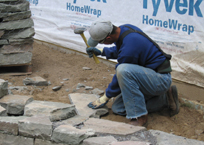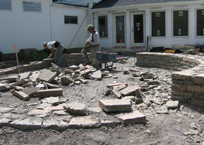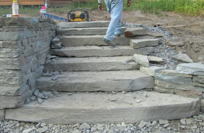Stone Practicalities

 In typical construction projects, we use stone for lots of purposes – as pavers, veneers or naturalistic landscape outcroppings, for instance. We also use plenty of stone in crafting the surfaces and banks and the areas surrounding our watershapes. But far and away the most common use for this material is in the building of retaining walls and stone fences.
In typical construction projects, we use stone for lots of purposes – as pavers, veneers or naturalistic landscape outcroppings, for instance. We also use plenty of stone in crafting the surfaces and banks and the areas surrounding our watershapes. But far and away the most common use for this material is in the building of retaining walls and stone fences.
In a technical/construction sense, walls and fences actually aren’t very different: Walls are built up against something that is being retained and are therefore faced on just one side; for their part, fences are basically free-standing walls faced on both sides. Whatever the form, dry-stacked walls and fences are built in similar ways using the same tools, and both require high degrees of precision and skill in the execution.
And these structures can be impressive. Stone fences can (and do) go on for miles across all sorts of terrain, while retaining walls can be built to great and almost incredible heights. (It’s not, however, particularly cost-effective to do so using classic dry-stacking methods, which is why many of the huge retaining walls you see along highways or as breakwaters are built as gabion walls in which large wire-mesh baskets are filled with rock. They can be unattractive, but I’ve seen some done with style and flair and they do get the job done.)
Before we get to the particulars of common wall and fence construction, however, we need to spend some time with the material itself and consider what’s involved in selecting the right stone for the job at hand.
The Right Stuff
There are countless types of rock available for use in building walls and fences.
 By and large, it’s most practical and cost effective to use stone that is native to the area in which you’re working. Obviously, this makes the bulky, heavy material less expensive to your client by minimizing handling and delivery costs.
By and large, it’s most practical and cost effective to use stone that is native to the area in which you’re working. Obviously, this makes the bulky, heavy material less expensive to your client by minimizing handling and delivery costs.
It’s amazing how much long-distance shipping of exotic material can add to a project’s price tag. It’s never my first choice to source products from the other side of the planet, but if a client is truly intent on building a wall or deck with a beautiful green stone from China, I know I can deliver the goods if the client is up for it.
In such cases, however, you must also factor in time: When you go to a local stone supplier and choose from various options, what you pick can be supplied almost immediately; with a long-distance source, you may need to factor many weeks of handling and shipping time into the process.
There’s yet another key factor to consider here – one that, I think, weighs heavily in favor of local sourcing: A native stone will look like it belongs, which can be crucial to delivering the sort of look that interests many of our clients.
Down to Business
Where I work in the Northeast, we’re lucky to have a number of great stone types available, including Pennsylvania Bluestone as well as limestone and fieldstone in various shapes, sizes and colors – all within five hours by truck, which is about the most-distant shipping radius I prefer.
 Beyond availability, workability is another major issue in stone selection. Each variety is different, with some stone types requiring lots of hand-working with a hammer to make them fit. Done properly, the resulting walls or fences will look great, but working individual stones consumes spectacular amounts of time and produces lots of waste you’ll need to deal with on the job site.
Beyond availability, workability is another major issue in stone selection. Each variety is different, with some stone types requiring lots of hand-working with a hammer to make them fit. Done properly, the resulting walls or fences will look great, but working individual stones consumes spectacular amounts of time and produces lots of waste you’ll need to deal with on the job site.
The plain fact is that we live in a budget-conscious society in tighter-than-usual times, all of which inclines me to gravitate toward local-source stones that are the most readily workable and also look great. This means we look for relatively flat stones to keep cutting and fitting down.
Where we are, this means we use lots of a local material called Colonial Wall Stone. On a good day, two experienced wallers can install about two tons a day, or about 25 to 30 face-square-feet. The key here is experience as well as familiarity with the basics of wall engineering – a topic we’ll take up next time.
Bruce Zaretsky is president of Zaretsky and Associates, a landscape design/construction/consultation company in Rochester, N.Y. You can reach him at [email protected].









